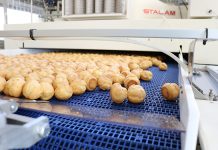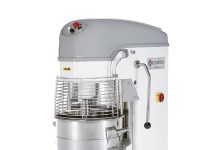How it works
 When extruded from the die, pasta has about 30% moisture. The surface is sticky and has the tendency to attach to anything it may come in contact with or mess with other closed pasta strings on the rank. To avoid this, pasta is ventilated by hot and humid air already at the rank loading phase; this ventilation causes a first reduction in the surface moisture and therefore stickiness. The inter-related factors controlling the capacity of air to remove moisture from the dough are the amount of water steam, the temperature, amount of air over the pasta, absolute humidity, moisture content, relative humidity and (RH) (in %). In pre-drying phase there’s a quick migration of the water particles from the inner part of the product toward the surface causing the evaporation of the humidity in excess. During the process the surface has to be detained from drying too much, this would close the interstices through which the remaining moisture can reach the surface by capillarity and so evaporate. Whenever it happens, the generated tensions will damage the product with crackings and crumbles also after a long while. The pre-dryer for long cut pasta is usually a unit made of a single level tunnel, separate from the drying line. Mechanical characteristics of the pre-dryers vary mainly according to the adopted technologies. The factors are thermo-hygrometric degree of the room and speed on which of the product passing through the tunnel. An even ventilation is a key factor to eliminate as steam, the water released from the heated pasta, the air should keep a high relative moisture rate inside the pre-dryer, to assure the essential condition for a normal water extraction. The dryer has usually more than one level from three to five or more. the course is longer, and longer is the time required for the drying stage to be ended. A multi- level course enables to reduce the dryer length and the length of the whole process. This unit dimensions are related to the manufacturer technology, in case of high temperature drying technology, the unit size is reduced since the process to achieve the final moisture value and its total stabilization is quicker, on contrary low temperature technology requires longer units. The not traditional microwave pasta drying equipments achieve rapid drying process and have high drying efficiency, pasta and instant noodles can be dried and sterilized simultaneously in a shorter time than in traditional tunnels. Microwave equipments are adopted by large-scale industrial pasta producers to speed up and to lower production costs. These tunnels have a high degree of automation, the temperature control and microwave output can be adjusted automatically. A cooling unit at the end of the tunnel reduces the pasta temperature and brings it back to room temperature. The pasta cooling may take place inside the dryer or in separate short tunnel. Cool humid air ventilated over the pasta is monitored by special probes that check the temperature and the moisture degree. After the cooling the racks are placed onto a stick-removing machine, which automatically removes the long pasta, cutting it at the desired length and ready for the packaging machine.
When extruded from the die, pasta has about 30% moisture. The surface is sticky and has the tendency to attach to anything it may come in contact with or mess with other closed pasta strings on the rank. To avoid this, pasta is ventilated by hot and humid air already at the rank loading phase; this ventilation causes a first reduction in the surface moisture and therefore stickiness. The inter-related factors controlling the capacity of air to remove moisture from the dough are the amount of water steam, the temperature, amount of air over the pasta, absolute humidity, moisture content, relative humidity and (RH) (in %). In pre-drying phase there’s a quick migration of the water particles from the inner part of the product toward the surface causing the evaporation of the humidity in excess. During the process the surface has to be detained from drying too much, this would close the interstices through which the remaining moisture can reach the surface by capillarity and so evaporate. Whenever it happens, the generated tensions will damage the product with crackings and crumbles also after a long while. The pre-dryer for long cut pasta is usually a unit made of a single level tunnel, separate from the drying line. Mechanical characteristics of the pre-dryers vary mainly according to the adopted technologies. The factors are thermo-hygrometric degree of the room and speed on which of the product passing through the tunnel. An even ventilation is a key factor to eliminate as steam, the water released from the heated pasta, the air should keep a high relative moisture rate inside the pre-dryer, to assure the essential condition for a normal water extraction. The dryer has usually more than one level from three to five or more. the course is longer, and longer is the time required for the drying stage to be ended. A multi- level course enables to reduce the dryer length and the length of the whole process. This unit dimensions are related to the manufacturer technology, in case of high temperature drying technology, the unit size is reduced since the process to achieve the final moisture value and its total stabilization is quicker, on contrary low temperature technology requires longer units. The not traditional microwave pasta drying equipments achieve rapid drying process and have high drying efficiency, pasta and instant noodles can be dried and sterilized simultaneously in a shorter time than in traditional tunnels. Microwave equipments are adopted by large-scale industrial pasta producers to speed up and to lower production costs. These tunnels have a high degree of automation, the temperature control and microwave output can be adjusted automatically. A cooling unit at the end of the tunnel reduces the pasta temperature and brings it back to room temperature. The pasta cooling may take place inside the dryer or in separate short tunnel. Cool humid air ventilated over the pasta is monitored by special probes that check the temperature and the moisture degree. After the cooling the racks are placed onto a stick-removing machine, which automatically removes the long pasta, cutting it at the desired length and ready for the packaging machine.



